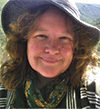The largest matriarch in the herd, she’s got a 7 body condition score any day of the week.
That much condition on a cow coming into fall has to mean pastures are in good shape. Or does it?
The truth of the matter is: Big Bertha’s not the cow you want to be using to determine if fall pastures are meeting your herd’s daily intake demands.
The matriarchal nature of a beef herd means that at any given time, there are probably some Big Berthas well over 6 years old, quite a few between 3 and 5, and a bunch of heifers that could easily take the place of two Berthas at the feedbunk this winter.
Are the nutritional needs of these cows being met?
Crude protein wanes
During the fall, crude protein wanes. Many calve in May to take advantage of lush green pastures. Which, while low in fiber, are out of sight for crude protein values. But unless you’re grazing some really lush regrowth, cows grazing permanent pastures in the fall are not walking around with green britches.
“Tallgrass native rangeland nutritive value, protein in particular, declines through the late summer and fall,” says David Lalman, Oklahoma State University Extension beef specialist.
Crude protein (CP) levels in October have declined and are only around 4 to 6 percent now in grass-based systems. That is quite an adjustment given spring CP values for common pasture weeds can exceed 18 percent, common grasses above 20 percent and legume forbs push 30 percent.
On fall pastures, cows with 5-month-old calves can get by on less protein (7 percent); but first-calf heifers are still growing and in need of 8 to 10 percent CP. In contrast, mature bulls will put on weight as their intake is just a little over 5 percent CP.
If you have early lactation cows in your herd at this time, they will have difficulty finding the recommended 10 percent CP they need to maximize milk production – thus taking away from the calf that needs at least 16 percent CP in daily intake to keep gaining. (See the Nutrient Requirements of Beef Cattle: Eighth Revised Edition (2016) for detailed CP values.)
Teeth and sward evaluation
Big Bertha has that hippo look to her mouth. You know what I mean: Her lips looked wider than her hips, and she is all gums. A ruler could lay flat on those incisor teeth. How she chewed her cud was beyond comprehension, which made me wonder: What was she eating?
Pasture swards in the fall are comprised of a lot of tough vegetation. New leaf tissue has slowed due to less hours of sunlight. Cows and calves are now eating higher-fiber plant material and will need good incisor teeth to cut tongue-pulled thatch and some length left to their molars to be effective at cud chewing.
Age aside, evaluating your herd’s mastication tools can give insight into how well they are paired up with the terrain. “Tooth wear can be related to the forage type and soil content.
For example, I might expect tooth wear to be higher on sandy soils and higher-fiber forages,” suggests Steve Boyles, Ohio State University Extension beef specialist. How far a cow’s teeth have worn will impact her ability to utilize higher-fiber forages common to fall pastures.
Young calves and mastication
Remember, young calves don’t have the ability to ruminate on forages at birth. It takes about six weeks for calves to become effective little cud chewers. Their ability to fully masticate high-fiber grass won’t come into play until closer to 6 months old. Lightweight calves on poor-conditioned cows that only have access to high-fiber swards is not going to increase gain on either pair. Why? As forage quality decreases, so does intake.
Without an influx of higher protein, calves will pull even more weight off these cows. If calves are to remain on these moms, consider segregating this group and supplement the cows’ forage with a protein tote and the calves’ intake with some creep feed. David Lalman agrees,
“The longer a pasture had been previously grazed and the higher the stocking rate, the fewer high-quality plant parts there are available to select from. This is one of many reasons it is not a good idea to overgraze: You are forced to supplement more and earlier. If cows are marginal or behind (thinner), we recommend getting started with a small amount of protein supplement in October soon after weaning to further stimulate forage consumption and digestion. As little as a half pound per day can improve cow body condition.”
Forage test
If you’re still unsure, taking a forage sample might be of value. I suggest taking a composite sample from a meter square at several locations. If you don’t want to clip with shears, a lawnmower or weed eater works great as long as you removed the inedible weeds beforehand. Mix the samples together. Then select enough to fill a brown paper lunch bag. Air dry the sample and send to a forage lab for analysis or freeze the sample and overnight ship it.
Lalman would expect tall grass prairie samples to be right in line with book values in October. “If one were to clip the forage in a 1-foot-by-2-foot rectangle at about the height of a rotary mower, then have the forage analyzed in a laboratory, I would expect the protein concentration to be about 4 to 6 percent.” ![]()
PHOTO: Pasture swards in the fall are comprised of a lot of tough vegetation, which is difficult to chew for the worn teeth of older cows. Photo by Melissa Bravo.

-
Melissa Bravo
- Certified Crop Adviser – Herd Health Specialist
- Meadow Lake Farm Consulting
- Email Melissa Bravo










